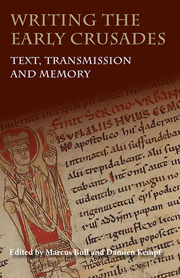Book contents
- Frontmatter
- Contents
- Acknowledgements
- List of Contributors
- List of Abbreviations
- Introduction
- Baldric of Bourgueil and the Familia Christi
- Guibert of Nogent, Albert of Aachen and Fulcher of Chartres: Three Crusade Chronicles Intersect
- Understanding the Greek Sources for the First Crusade
- The Monte Cassino Tradition of the First Crusade: From the Chronica Monasterii Casinensis to the Hystoria de via et recuperatione Antiochiae atque Ierusolymarum
- Nova Peregrinatio: The First Crusade as a Pilgrimage in Contemporary Latin Narratives
- What Really Happened to Eurvin de Créel's Donkey? Anecdotes in Sources for the First Crusade
- Porta Clausa: Trial and Triumph at the Gates of Jerusalem
- The Historia Iherosolimitana of Robert the Monk and the Coronation of Louis VI
- Towards a Textual Archaeology of the First Crusade
- Robert the Monk and his Source(s)
- Rewriting the History Books: The First Crusade and the Past
- The Ideal of Knighthood in English and French Writing, 1100–1230: Crusade, Piety, Chivalry and Patriotism
- Index
Nova Peregrinatio: The First Crusade as a Pilgrimage in Contemporary Latin Narratives
Published online by Cambridge University Press: 05 May 2014
- Frontmatter
- Contents
- Acknowledgements
- List of Contributors
- List of Abbreviations
- Introduction
- Baldric of Bourgueil and the Familia Christi
- Guibert of Nogent, Albert of Aachen and Fulcher of Chartres: Three Crusade Chronicles Intersect
- Understanding the Greek Sources for the First Crusade
- The Monte Cassino Tradition of the First Crusade: From the Chronica Monasterii Casinensis to the Hystoria de via et recuperatione Antiochiae atque Ierusolymarum
- Nova Peregrinatio: The First Crusade as a Pilgrimage in Contemporary Latin Narratives
- What Really Happened to Eurvin de Créel's Donkey? Anecdotes in Sources for the First Crusade
- Porta Clausa: Trial and Triumph at the Gates of Jerusalem
- The Historia Iherosolimitana of Robert the Monk and the Coronation of Louis VI
- Towards a Textual Archaeology of the First Crusade
- Robert the Monk and his Source(s)
- Rewriting the History Books: The First Crusade and the Past
- The Ideal of Knighthood in English and French Writing, 1100–1230: Crusade, Piety, Chivalry and Patriotism
- Index
Summary
Despite a considerable historiography on the crusades, there are still flickers of division among historians as to the definition of a crusade, or rather, divisions as to when all the features of a crusade became established. The First Crusade suffers the most from this tendency. Although it was the first campaign of its kind which historians agree to be definable as a ‘crusade’, the campaign of 1096–9, like many ‘firsts’, did not have all of the features of a crusade in a fully developed form. For example, the indulgence, which became a defining characteristic of the crusades, was in all likelihood not legally established or universal until almost fifty years after its origins were mooted at the Council of Clermont. Some of this tension arises because modern terms to define a crusade come with accumulated inferences and meanings which are anachronistic when applied retrospectively. The term ‘pilgrimage’ is such a contentious term, given its implications of an unarmed endeavour, and it is often qualified. The crusade was, therefore, an ‘armed pilgrimage’ or a ‘crusade-pilgrimage’ the crusaders were ‘warrior pilgrims’. Although a seemingly contradictory impulse, the term ‘pilgrimage’ became associated with the crusade because the Latin peregrinatio was frequently used by contemporaries for these expeditions.
- Type
- Chapter
- Information
- Writing the Early CrusadesText, Transmission and Memory, pp. 63 - 74Publisher: Boydell & BrewerPrint publication year: 2014



